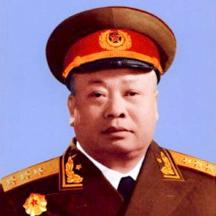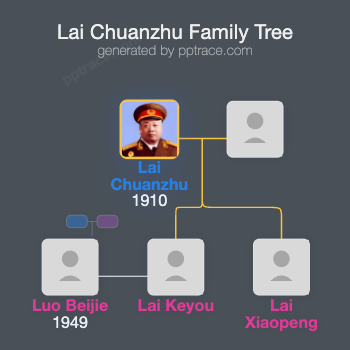
Lai Chuanzhu
| Name | Lai Chuanzhu |
| Title | Chinese politician |
| Gender | Male |
| Birthday | 1910-04-03 |
| nationality | People's Republic of China |
| Source | https://www.wikidata.org/wiki/Q8299349 |
| pptrace | View Family Tree |
| LastUpdate | 2025-10-01T10:10:00.283Z |
Introduction
Lai Chuanzhu (April 3, 1910 – December 24, 1965), was a native of Lai Village, Dabu Township, Ganshi County, Jiangxi Province. Born into a peasant family; his father was Lai Jifang. In his early years, Lai studied at Gannan Middle School in Ganzhou, during which he read extensively from Marxist-Leninist publications and received revolutionary ideological education.
In the autumn of 1924, Lai entered Gannan Middle School with excellent academic performance, actively participated in student organizations, and supported revolutionary movements. After the May Thirtieth Movement broke out, he actively took part in fundraising, demonstrations, and protests at factories, schools, and shops to support the Shanghai workers’ strike. He also promoted land revolution and armed self-defense among farmers, organized peasant self-defense armies, and helped establish farmers’ associations.
In November 1926, Lai joined the Chinese Communist Youth League. After Chen Zanxian, vice-chairman of the Jiangxi General Federation of Trade Unions and chairman of the Ganzhou Federation, was assassinated in January 1927, and under the influence of the White Terror, he resolutely joined the Communist Party of China in April of the same year. Subsequently, he served as secretary of the party branch in Baishi Township, Ganzhou, organized armed uprisings among farmers, and achieved the first successful peasant uprising.
Lai once participated in the Workers’ and Farmers’ Revolutionary Army in Rucheng, Hunan, serving as a party representative. Later, he accompanied the Red Army to participate in the August 1 Nanchang Uprising, leading the peasant Red Guards in Ganshi County to initiate armed insurrection. From 1930 to 1931, he participated in multiple anti-encirclement campaigns, served as political commissar of various detachments, repeatedly advocated land reform and mass armed movements, and was wounded several times during battles.
In October 1934, when the Long March began, Lai was appointed political commissar of the 1st Division of the Red Army Corps. He led his troops to break through blockades, successfully coated the main force across the Xiang River, and, guided by the spirit of the Gutian Conference, actively implemented and promoted the Party’s directives. During the Long March, he was severely wounded in Guizhou but demonstrated unyielding perseverance. Afterwards, he participated in several significant battles.
During the Anti-Japanese War, Lai served as Director of the Staff Department of the New Fourth Army headquarters and as Chief of Staff of the Jiangbei Command. He led troops to repulse the enemy in eastern Anhui and establish guerrilla bases behind enemy lines. After the Wan-Nan Incident, he was appointed Chief of Staff of the New Fourth Army and a member of the Central China Bureau, making important contributions to the war effort behind enemy lines. In the 1945 counteroffensive, he commanded the capture of several key counties and destroyed numerous Japanese and puppet forces.
During the Liberation War, Lai served successively as Deputy Commander of the Jilin Military District and Political Commissar of the 6th Column of the Northeast Field Army, participating in campaigns in Liaoning and Pingjin areas. After the founding of the People’s Republic of China, he led troops to successfully land on Hainan Island, defeating many enemies, developing local armed forces, and restoring border areas.
After the founding of New China, Lai held major positions such as Political Commissar of the Beijing Military Region and Second Political Commissar of the Shenyang Military Region. He promoted military development, established models like Lei Feng, and made significant contributions to political work in the armed forces. In 1955, he was awarded the rank of General of the Chinese People's Liberation Army and received the First Class August 1 Medal, the Medal of Independence and Freedom, and the Medal of Liberation.
Lai Chuanzhu died of illness in Shenyang on December 24, 1965, at the age of 55. His tomb is located at the Baoshan Revolutionary Cemetery in Beijing. His life has been commemorated and evaluated in numerous documents and documentaries, establishing him as an important military leader in China’s liberation movement.
Family Tree
Tap to expand more relatives
